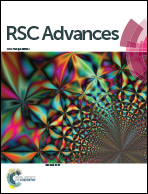Fluorinated polyurethane based on liquid fluorine elastomer (LFH) synthesis via two-step method: the critical value of thermal resistance and mechanical properties
Abstract
Until now, only few hydroxy-terminated fluorinated monomers were reported as soft segment. In this work, based on a novel hydroxy-terminated liquid fluorine elastomer (LFH), a series of FPUs were synthesized via a two-step method. Flexible soft segment polytetrahydrofuran glycol (PTMG) was applied as the second soft segment. FTIR and GPC results indicated that the fluorinated groups were introduced into the structures of copolymers, and all the monomers were copolymerized successfully. TGA, DMTA and conventional mechanical analysis show that FPU gains optimal thermal stability and mechanical properties when the dosage of LFH is increased to a critical value of 18 wt%, even after the cured films being immersed into hot water and oil. Additionally, the surface properties of FPUs can be highly changed as a small amount of fluoride (6 wt%) is introduced into the structures of copolymers, due to the effect of fluorine enrichment. Consequently, LFH can effectively improve the thermal stability, mechanical properties, water resistance and organic solvent resistance of polyurethane within limits. Besides, these mentioned controllable properties of FPU can be achieved by changing the dosage of LFH. This work will help to achieve the best balance between performance and cost in industrial production.



 Please wait while we load your content...
Please wait while we load your content...